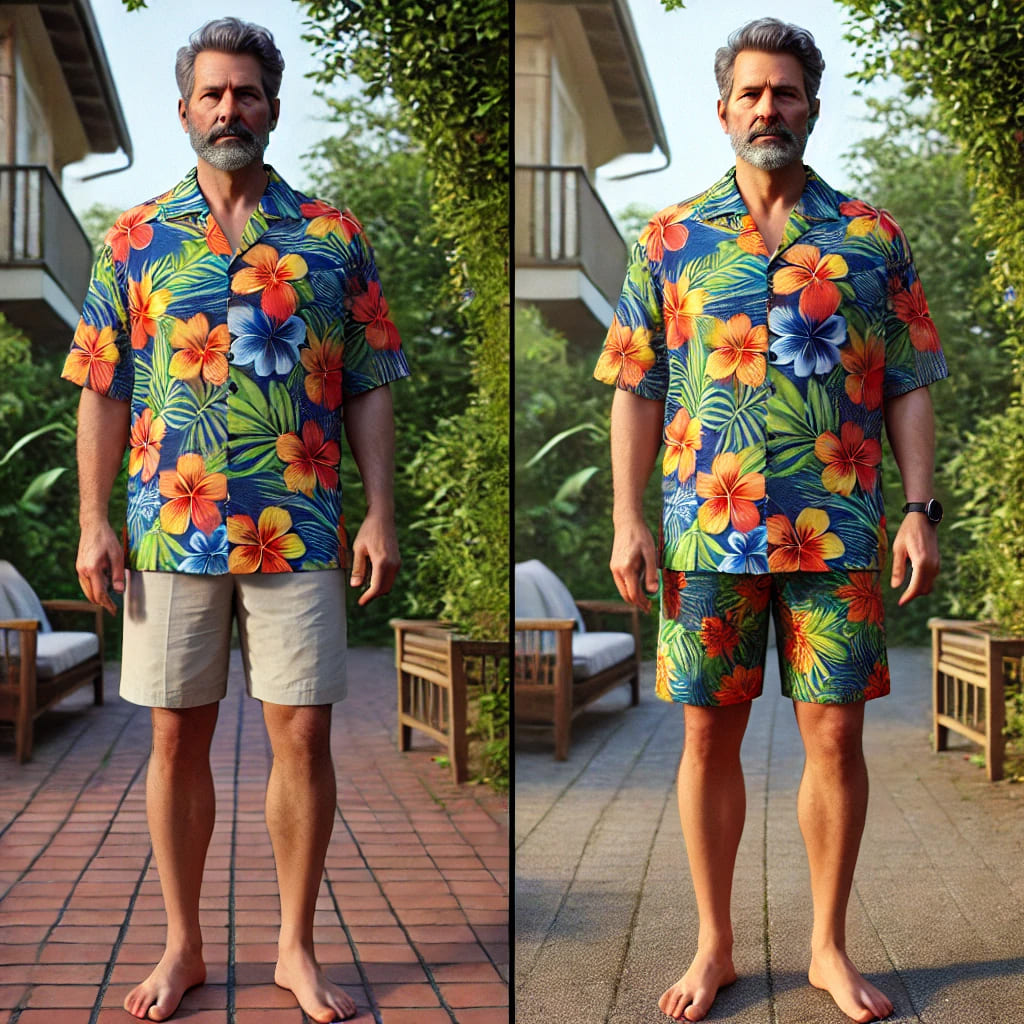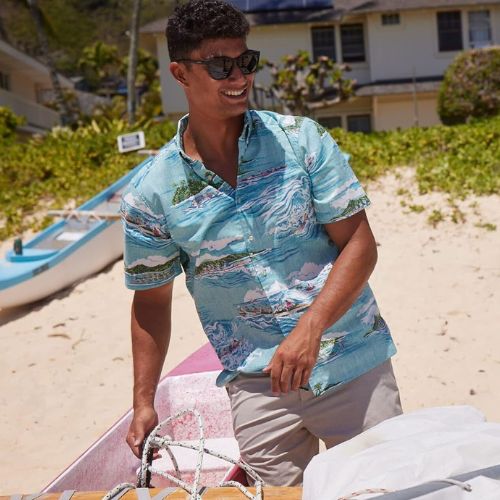The Hawaiian shirt, regularly known as an “Aloha shirt” in Hawaii, has gotten to be a worldwide image of the islands. Initially fair a straightforward flower print shirt, it has changed over the a long time into the notorious Hawaiian shirt we know nowadays. Beginning within the 1930s, the fashion of Hawaiian shirts has advanced nearby other mold patterns. Here are a few intriguing truths almost the origin of Hawaiian shirts, your go-to Hawaiian shirt asset.
What Is The Origin Of Hawaiian Shirts?
Early Hawaiian Wear
Some time recently the presentation of woven textures from China, Japan, and the West, local Hawaiians made their clothing from innate plants and trees. Men wore a malo, or loincloth, made from tapa cloth, which was inferred from the internal bark of wauke trees. This fabric was very diverse in appearance and surface from the rayon or cotton utilized in advanced Hawaiian shirts. Conventional Hawaiian ladies wore a skirt called a pa`u, comparative in fashion to a hula skirt. These skirts are still seen nowadays in oddity stores or at Hawaiian luaus.

A Tapa for All Occasions
Tapa cloth was known for being tough, durable, and versatile. It was ideal for clothing and made excellent floor coverings. Due to the origin of Hawaiian shirts and flat surface, it was also easy to decorate.
Across Polynesia, tapa cloth served as an artist’s canvas, with people hand-painting their creations in vibrant colors and intricate designs inspired by their surroundings. Common motifs included tropical flowers and lush green leaves. The vibrant patterns seen on modern Hawaiian shirts and dresses trace back to these beautiful Polynesian tapa prints.
The Ever Popular Palaka Shirt
In the late 19th and early 20th centuries, Hawaii’s booming plantation economy thrived on the export of sugar, pineapple, and coffee. Plantation workers needed durable shirts for the demanding labor in the fields and Hawaii’s hot, unpredictable weather.
Within a generation, the checkered blue and white denim palaka shirt became the standard work attire in Hawaii. By the early 1930s, these palaka shirts and blue denim trousers known as sailor-mokus, initially worn by field workers, had almost become Hawaii’s unofficial national costume, both on and off the plantations.
The origin of hawaiian shirts from Kimono to Ono
In the early days, shirts were handcrafted, either at home or by custom tailors. These tailor shops quickly appeared across the islands, especially in plantation towns and Honolulu.
Dry goods stores offered a variety of new fabrics from around the world, including printed silk from Japan, raw silk, batik, rayon from the U.S. mainland, and cotton for kimonos and yukatas. Asian immigrants significantly influenced history of hawaiian shirts, and this was reflected in fashion.
Shirts and women’s dresses, both short- and long-sleeved, were inspired by Asian garment designs and made from pre-printed fabrics from China and Japan. These vibrant shirts and dresses were the direct ancestors of modern Aloha wear. In Hawaii, we say “ono” to mean deliciously cool.

First real hawaiian designs
It wasn’t until the mid-1930s that Hawaiian clothing manufacturers began producing fabric with distinctively Hawaiian designs.
Leading this movement, Watumull’s East India Store hired artist Elsie Das to create fifteen floral patterns, marking the birth of the Hawaiian print we know today.
Her exquisite hand-painted designs were sent to Japan, where they were manually printed onto raw silk, which was then fashioned into clothing.
Satin mistakes and hollywood dreams
Hawaiian fabric designer Elsie Das recounted an incident where a Japanese manufacturer mistakenly printed her floral designs on heavy satin. “These initiated a trend in Hollywood. Celebrities like Ginger Rogers and Janet Gaynor bought rolls of the fabric and turned them into ‘seductive gowns.’
This sparked a nationwide craze for Hawaiian designs, with hibiscus and ginger motifs appearing on tablecloths, napkins, and scarves across the country,” as detailed in the article “Elsie Das, Artist Designer” by William Davenport in Paradise of the Pacific, p. 9, 1963.
The “first” aloha shirt

In the early 1930s, the term “Aloha shirt” likely originated as street slang, referring to the increasing number of shirts with Oriental and Hawaiian designs made by Honolulu tailors.
Musa-Shiya, the Shirtmaker, first advertised the “Aloha shirt” on June 28, 1935, in the Honolulu Advertiser: “Honolulu’s Noted Shirt Maker and Kimono Shop. ‘Aloha’ shirts – well tailored, beautiful designs and radiant colors.
Ready-made or made to order 95 cents up.” Another version credits an advertising salesperson from the Honolulu Advertiser and Ellery Chun, owner of the King-Smith dry goods store, with coining the term. Chun officially trademarked his Aloha sportswear on July 15, 1936.
Hawaiian shirts in Hollywood

Hollywood played a critical part in popularizing Hawaiian shirts. Celebrities, counting motion picture stars and lawmakers, showcased these vibrant plans, making a difference them enter mainstream mold. In “From Here to Endlessness,” Montgomery Clift, Burt Lancaster, Ernest Borgnine, and Frank Sinatra wore in vogue Hawaiian shirts.
Ginger Rogers wore glossy silk outfits with Hawaiian themes, while Bing Crosby matched his Hawaiian shirt with a porkpie cap. Betty Grable postured in a Hawaiian-style bathing suit for a 1940s promo pin-up shot.
Within the 1980s, Tom Selleck’s famous “Magnum P.I.” Hawaiian shirt got to be so famous it presently dwells within the Smithsonian Museum of American History. Other stars like Elvis Presley and Jimmy Buffet moreover contributed to the far reaching popularity of Hawaiian shirts.
Border Hawaiian Shirts
Border Hawaiian shirts stand out due to their unique symmetry, making them exceptionally appealing. By today’s standards, they are considered luxurious because a significant amount of fabric is wasted during production. These shirts showcase meticulously designed patterns where sleeves, sides, and hems match perfectly.
Even the pockets often align seamlessly with the shirt’s pattern, and some designs do not repeat at all on a single shirt. Typically, border Hawaiian shirts are longer to display the fabric’s intricate images, which is why they should not be tucked in. This meticulous tailoring method is also used for creating beautiful sundresses.
The border shirt is quite similar to the engineered print Hawaiian shirt, with the main difference being that engineered shirts have even wider images, often extending from seam to seam.
Conclusion
These days, Aloha wear or Hawaiian shirts stay well known among sightseers, Hawaiian local people, and anybody needing to grasp the island way of life. These dynamic shirts include strong colors, perplexing designs, and tropical prints that inspire the origin of Hawaiian shirts. If you’re seeking out for a unused Hawaiian shirt, dress, or other Salaam wear, check out Aloha FunWear for the latest styles and bring a chunk of the islands into your closet.
Share this

Alex Ivanovs
Alex is a freelance writer with more than 10 years of experience in design, development, and small business. His work has been featured in publications like Entrepreneur, Huffington Post, TheNextWeb, and others. You can find his personal writing at The Divine Indigo.





